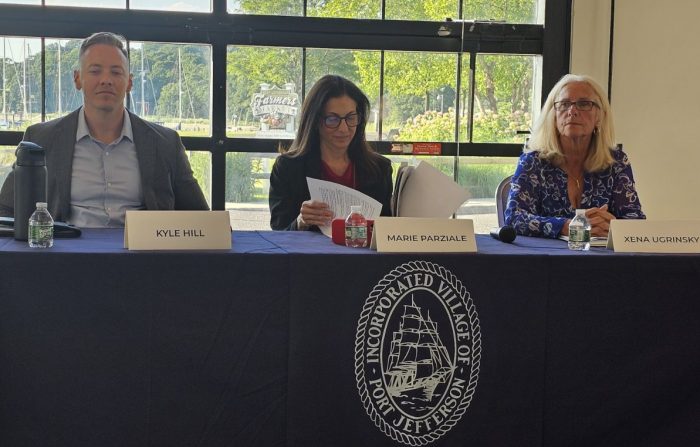Skyler Johnson, a progressive vision for New York State Assembly
The November 2024 election is one that will determine the direction our country is headed in, whether we will value environmental protection, reproductive rights and a New York state where everyone can thrive. This doesn’t only apply to the top of the ticket, but down ballot as well. State and local government is where policies are enacted that deeply impact our day to day lives. It is for that reason that I am so excited to support Skyler Johnson for Assembly.
Skyler is exactly the kind of candidate I want to see in office — he stands unequivocally for economic, environmental and social progress in New York state. I know this because I have seen him show up time and again on the issues that impact New Yorkers. Skyler has joined striking autoworkers in picket lines at South Shore Kia in Copiague and striking health care workers at Cold Spring Hills rehabilitation facility in Woodbury. His advocacy has earned him the endorsement of the local 1199SEIU. He has stood with the North Bellport community calling for the closure and remediation of the Brookhaven landfill. He serves as a board member at Planned Parenthood Hudson Peconic and is endorsed by Planned Parenthood Empire State Votes. Skyler has also been endorsed by the LGBTQ+ Victory Fund and Equality NY. I know that when Skyler goes to Albany, he will protect our workforce, our environment, LGBTQ+ rights and our reproductive freedom.
On a deeply personal note, Skyler and I are both congregation members at Temple Beth Emeth in Mount Sinai, where Skyler serves on the board. In a time where antisemitism is on the rise, I deeply appreciate his leadership in our local Jewish community, and am grateful to share this space with Skyler and his family.
Skyler’s record stands in stark contrast with our current Assemblyman Ed Flood [R-Port Jefferson], who has voted against the Equal Rights Amendment ballot initiative, against fully funding our public schools and against environmental legislation. After being represented by former Assemblyman Steve Englebright [D-Setauket] for decades, I look forward to this seat returning to a community champion like Skyler.
Actions speak louder than words. And I have seen Skyler in action, on the moral side of the issues that matter, time and again. I look forward to sending Skyler to Albany, and to being represented by him.
Shoshana Hershkowitz
South Setauket
Three Village Meals on Wheels celebrates 40 years
On Aug. 22, 1983, 13 clients received meals for the first time from Three Village Meals on Wheels using eight volunteers. Forty years later, more than 65 clients are receiving meals and 50-plus volunteers are delivering the meals.
Meals on Wheels began when some local community members saw a need for a meal program in the Three Village area. They hoped to get the program government sponsored. That provision came with specific age requirements for our clients so the idea for a privately sponsored program was discussed.
A meeting in Setauket was held with 40 people in attendance. Spearheading this plan was Adelaide Silkworth who was the director of the Suffolk County Office for the Aging. After an overview of the Town of Huntington’s privately sponsored, home delivery meal program was presented, several organizations volunteered their services for fundraising, seed money, printing and public relations.
Next a steering committee was established and the first meeting took place at the Stony Brook Community Church where the office continues to reside.
Soon the organization had a chair, secretary, dietary coordinator, screening nurses and a coordinator of volunteers. The group soon became known as Three Village Meals on Wheels.
A state grant sponsored by Sen. James Lack [R-District 2] got the program off the ground and a month later, the staff of the Office for the Aging met with administrators from St. Charles Hospital and John T. Mather Hospital in Port Jefferson. Both hospitals were on board to provide meals for 20 to 25 people.
The program today fluctuates in number of clients but continues delivering meals to an ever-growing population of homebound frail, elderly, convalescent and handicapped people who need support to retain their independence. A great organization was born 40 years ago and continues to thrive today with the help of a once-a-year fund drive, generous donations and varying grants to enable this program to remain independent. If you know someone who would benefit from this service, would like to donate or volunteer, call the office 631-689-7070.
Diane Melidosian
Stony Brook
Three Village MOW Board Member
Vote for Ugrinsky’s proven leadership
Our village needs a proven leader, someone who will work tirelessly to protect and enhance our community. Xena Ugrinsky is that person. Xena and I work together on the village’s Budget & Finance Committee and I have been impressed with both her financial expertise and her work ethic. She will bring the best thinking from the private sector to ensure our scarce tax dollars are spent judiciously.
Xena’s resume is also impressive, with over 30 years of corporate and financial management experience. She has the know-how to help craft workable solutions to some of our most pressing issues, including the bluff erosion, the occasional flooding of our downtown and the potential loss of significant revenue from the power plant. Xena will champion making the plant a state-of-the art energy facility that will preserve not only the village’s tax base but the school district, too.
Her proficiency in project management will be invaluable for our public works infrastructure and enable her to keep a close eye on capital expenditures, so we don’t overpay or end up with excessive change-order requests. Port Jefferson needs someone with Xena’s experience on the board. That’s why I’m voting for Xena Ugrinsky for village trustee on June 18.
William Gatta
Port Jefferson
Member of Budget & Finance Committee
Looking forward with Ugrinsky and Parziale
As mayor, I’d like to first express my gratitude, on behalf of the Village of Port Jefferson, to outgoing trustees Drew Biondo and Rebecca Kassay for all their hard work over the past year. We had a very successful year and while we didn’t always agree and tough questions were brought forward, ultimately this board was effective and efficient making unanimous decisions on all but one or two issues.
Now we have to look toward the future, and who best to step up and into these two open trustee seats. I commend the three candidates who have stepped up and put themselves out there for public scrutiny and mudslinging.
That said, my votes are going to Xena Ugrinsky and Marie Parziale (Johs).
Why? Because they are the two most qualified candidates. Their respective resumes are diverse and jam-packed with relevant experience. Each has worked directly in the areas in which they are committed to contribute as village trustees. Xena brings her project management skills, years of work in the finance and energy sectors, and more recently her entrepreneurial activity in alternative energy generation. She currently chairs the village Power Plant Working Group and is a member of the village Budget & Finance Committee, and she chaired the Port Jefferson election review committee to its conclusion.
Marie has been rolling up her sleeves as a volunteer in Port Jefferson for years — at Harborfront Park, the Village Center and the Children’s Maritime Museum (now the Explorium) — while her children were young and going through Port Jefferson schools. She then pursued an advanced degree in social work and now, as senior alumni career coach at Stony Brook University, she is connecting students and alumni to careers with businesses locally, throughout Long Island and beyond, forging relationships that she can build upon further to benefit our community as a village trustee.
They are both fully engaged and ingrained in our community and both will hit the ground running. It would be my honor to work with each of them on this new board because while I did become mayor with the help of a rubber stamp, we do not need that trait in a board. This administration respects diversity of thought, intellect, and encourages debate and dialogue to get to the right decisions for village residents, and I’m confident that’s what Xena and Marie will bring to the table.
Lauren Sheprow
Mayor of Port Jefferson Village
Social media is not a reliable source
Has the Port Times Record now resorted to regurgitating Facebook posts under the guise of “reporting”?
In the June 6 edition, the article “Incident in Port Jefferson Village exposes communication failures” is almost entirely composed of one such Facebook post.
Were there no other sides to the story? The article states, “Seeking clarity and answers, an email was sent to village officials on May 31.” Was this request sent by the newspaper? Did the reporter attempt to contact the police department for the details of the stabbing and learn their view of whether this event constituted a threat to the community warranting an alert? Did the reporter attempt to call the mayor or trustees to get clarification and advise them that a story was being prepared for publication?
I don’t view social media posts as a reliable source of news events and expect more from the Port Times Record.
Robert J. Nicols
Port Jefferson
The art of deception
In the chessboard of political strategy, concern is often a pawn masquerading as a queen. It’s a Trojan horse, cloaked in the guise of public interest, yet filled with the soldiers of self-serving agendas. This duplicity is the essence of a political dirty trick, where genuine worry is feigned to serve a darker purpose.
These maneuvers are designed to deceive, to cast a shadow of doubt or to rally support through manufactured sincerity. The public, often unaware of the machinations behind the scenes, may be swayed by these displays of false concern.
Yet, in the long run, such tactics can backfire. When the veil is lifted, and the true intentions are revealed, the architects of these deceptions may find themselves facing the very scrutiny they sought to avoid.
Trust, once broken, is not easily mended.
Authenticity is the currency of real change, and without it, political gambits are but empty gestures.
Drew Biondo
Trustee
Port Jefferson Village
Editor’s note: As per TBR policy, we do not publish endorsements the week immediately before elections as it does not allow time for rebuttals. Letters of endorsement can be found on our website, tbrnewsmedia.com, under “Letters”, which is available 24/7. Thank you for your continued readership.
















